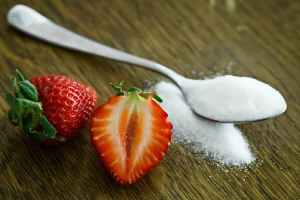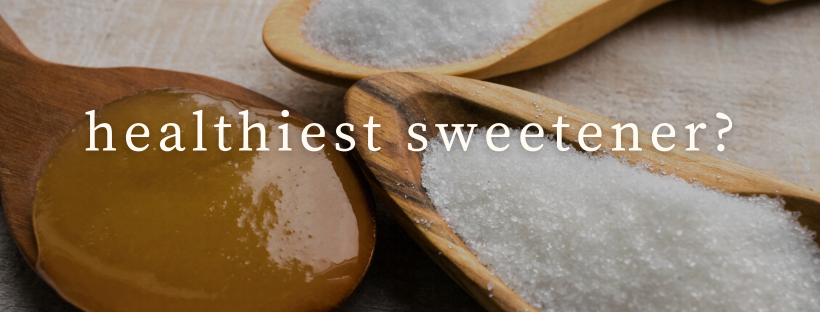Whenever I search for healthy treat recipes, I inevitably stumble upon a number of recipes claiming to be “guilt free” or made with “100% healthy ingredients.” My favorite is when a recipe says, “No sugar added!” but then has loads chocolate chips, a cup of maple syrup, etc.
Let’s be clear. When you add a sweetener like maple syrup or honey, you are still. Adding. Sugar. (If you don’t believe me, check out what the FDA classifies as “added sugar.”)
That said, these fancy sweeteners might be a little healthier. I decided to get down to the nitty gritty and figure out exactly what the health costs and benefits are to some of the most common “healthy” sweeteners (as compared to regular sugar). And of course, I threw in a cost comparison too.
The Comparison Factors
I could have chosen so many measures to compare these sweeteners. So what am I using as a comparison, and why did I choose it? Here’s my list.
Calories per Tablespoon
While calories aren’t everything, they are something. Usually calories coming from a sweetener are considered “empty” calories, which is certainly something you want to limit. That said, you may need to use a smaller amount of the more concentrated sweeteners (see the next section), so keep that in mind as you think about calorie count.
Grams of Sugar per Tablespoon
This number isn’t necessarily good or bad, but it’s still a helpful measure to know. The grams of sugar per tablespoon helps us know how sweet our sweetener will taste. So the higher it is, the less of it you’ll have to use. That said, you’ll still be getting the same amount of sugar either way. But this might affect the calories you get or the cost of the product. For example, while honey is more expensive than table sugar, you also have to use a little less of it since its sugar concentration is higher.
Glycemic Index
You may have heard about Glycemic Index before, but like me, maybe you aren’t really sure what that means. According to the official Glycemic Index website from The University of Sydney, “The glycemic index (or GI) is a ranking of carbohydrates on a scale from 0 to 100 according to the extent to which they raise blood sugar (glucose) levels after eating.” Higher numbers mean a bigger spike in blood sugar. Foods with a low GI may be better for preventing/managing diabetes and cholesterol as well as managing weight.
Antioxidant Content
At first I wasn’t sure if I wanted to include this, because let’s be real — most healthy foods already have the antioxidants you need. The foods most rich in antioxidants are things like berries, nuts, dark green veggies, orange veggies, etc. (All stuff you should be eating for other reasons too, like vitamin content, fiber, and more.) But. Antioxidants are still good for you, so I thought I’d include it since it’s one of the saving graces of these healthier sweeteners.
Antioxidant content is measured in ferric-reducing ability of plasma (FRAP) mmol/100 g. The higher the number, the greater the antioxidant content.
Cost per Ounce
Why did I include cost? While I am willing to pay a little extra for the sake of my health, it helps to know just how much extra something will cost. Because let’s face it. If something costs 5x as much for only minimal health benefits, I’m not gonna buy it.
Granulated Sugar

First, let’s check out the regular, granulated cane sugar most people buy at the store. This table sugar is scientifically called sucrose, made up of the monosaccharides glucose and fructose.
For our starting point in comparison, a tablespoon of sugar has about 22.5 calories (or kilocalories, if you want to get technical). It also has 12 grams of sugar per tablespoon. Table sugar comes in at a GI of 60, with minimal to no antioxidants. The plus side is, this sweetener is nice and cheap at $0.03 per ounce.
| Calories per Tbsp (kcal) | Sugar per Tbsp (g) | Glycemic Index (GI) | Anti- Oxidant | Cost ($/oz) | Other | |
| Granulated Sugar | 22.5 | 12 | ~60 | 0.009 | $0.03 | Really cheap! But zero nutrition. |
(I used the nutrition facts and cost from a four pound bag of Great Value granulated sugar. Glycemic Index info comes from The University of Sydney’s Glycemic Index. Anti-oxidant info taken from a study published in the Journal of the American Dietetic Association.)
Honey

Like many foods, not all honey is created equal. The raw, local, darker colored honey will likely be higher in anti-oxidants and other nutrients. Unfortunately, the more nutrient dense honey comes with a pretty big price tag, often coming in around $0.30 or $0.40 per oz, or about $5-6 for a 16 oz jar. Honey may have some other benefits, like lowering bad cholesterol. Honey has a higher calorie count than table sugar at 60 calories per tablespoon. But it also has a higher sugar concentration (16 g per Tbsp), so hopefully you can get away with using less of it.
| Calories per Tbsp (kcal) | Sugar per Tbsp (g) | Glycemic Index (GI) | Anti- oxidant | Cost ($/oz) | Other | |
| Honey | 60 | 16 | 48-72 Average ~60 | 0.156 | $0.29 – local $0.16 – light, 5 lb jug | -May lower bad cholesterol -Not all honey is equal |
(I used the nutrition facts and cost from a local 24 oz jar of honey sold at Walmart and from a cheaper 5 lb jug sold at Walmart. Glycemic Index info comes from The University of Sydney’s Glycemic Index. Anti-oxidant info taken from a study published in the Journal of the American Dietetic Association, which averaged several different types of honey.)
Maple Syrup

Some people choose maple syrup instead of honey because it’s a plant based sweetener. (Save the bees, right?) Maple syrup, like honey, comes in different forms with varying levels of health benefits. For example, darker colored maple syrup may have greater antioxidant content. Maple syrup also has a small amount of minerals that can be beneficial. Its calorie count and sugar content is closer to table sugar, with 52.5 calories and 12.75 g sugar per tablespoon. It can have a slightly lower Glycemic Index, though like honey, this varies. The average antioxidant content is slightly higher than honey at 0.412 mmol/100 g. Maple syrup’s big kicker is the large price tag at $0.44 per ounce.
| Calories per Tbsp (kcal) | Sugar per Tbsp (g) | Glycemic Index (GI) | Anti-oxidant | Cost ($/oz) | Other | |
| Maple Syrup | 52.5 | 12.75 | 54-68 | 0.412 | $0.44 | -Has some beneficial minerals like manganese, zinc, & iron |
(I used the nutrition facts and cost from a 32 oz jug of pure maple syrup sold at Walmart. Glycemic Index info comes from The University of Sydney’s Glycemic Index. Anti-oxidant info taken from a study published in the Journal of the American Dietetic Association.)
Agave Nectar

Agave nectar, which should more accurately be called agave syrup, is an interesting one. It has a similar sugar and calorie content to honey (16 grams sugar and 60 calories per tablespoon, according to the nutrition label). But the real standout here is the glycemic index. Agave nectar comes in at only 10-19! That’s significantly lower than all the other sweeteners in this article.
When I read that, I instantly thought, then why aren’t doctors recommending that everyone use agave nectar as their sweetener?
Yup, you guessed it. That low glycemic index looks good, but it comes with a price. Agave nectar’s main sugar component (75-90%) is fructose.
You’re probably thinking, Isn’t that what’s in fruit? Why is that so bad?
Well it took a little digging for me to understand this one. But basically, your liver is the only part of your body that can digest fructose. And fructose gets turned into fat. So if you have a high concentration of fructose (think high fructose corn syrup, fruit juice, etc.) without the normal fiber and nutrients and whatnot found in fruit, then that causes problems for your liver. There’s some evidence linking high fructose consumption with fatty liver disease.
What’s more, agave nectar, like regular sugar, has little to no antioxidants.
So while agave nectar is probably better for avoiding blood sugar spikes, like the other sweeteners, it still should be consumed in moderation.
| Calories per Tbsp (kcal) | Sugar per Tbsp (g) | Glycemic Index (GI) | Anti- oxidant | Cost ($/oz) | Other | |
| Agave Nectar | 60 | 16 | 10-19 | 0.010-0.019 | $0.23 | -Higher in fructose than other sweeteners |
(I used the nutritional values & cost from a 24 oz bottle of organic amber agave from Walmart. Glycemic Index info comes from The University of Sydney’s Glycemic Index. Anti-oxidant info taken from a study published in the Journal of the American Dietetic Association, which averaged several different types of agave nectar.)
Which Sweetener is Best?
Sweeteners are still going to give you extra added sugars. But the main benefit from an alternative sweetener would be a small amount of added antioxidants, and potentially a lower spike in your blood sugar (lower Glycemic Index).
One study explains, “Based on an average intake of 130 g/day refined sugars and the antioxidant activity measured in typical diets, substituting alternative sweeteners could increase antioxidant intake an average of 2.6 mmol/day, similar to the amount found in a serving of berries or nuts.”
As you can see from the table below, pure maple syrup is the most antioxidant rich of these sweeteners. However, it’s also the most expensive. While it does contain more antioxidants than the others, you have to ask yourself if the small amount is worth the cost. (For comparison, antioxidant rich foods like kale have 2.8 mmol/100 g compared to maple syrup’s 0.412 mmol/100 g. You’d have to eat a lot of syrup to get the same amount of antioxidants.)
| Sweetener | Calories per Tbsp (kcal) | Sugar per Tbsp (g) | Glycemic Index (GI) | Anti- Oxidant | Cost ($/oz) | Other Stuff |
| Cane sugar (4 lb bag) | 22.5 | 12 | ~60 | 0.009 | $0.03 | -Totally empty calories |
| Honey (raw & local) | 60 | 16 | 58 | 0.156 | $0.29 | -Potential allergy benefits from local -More antioxidants |
| Honey (filtered) | 60 | 16 | ~60 | 0.156 | $0.16 | -Lighter color = fewer anti-oxidants |
| Maple syrup (32 oz) | 52.5 | 12.75 | 54-68 | 0.412 | $0.44 | |
| Agave nectar | 60 | 16 | 10-19 | 0.010-0.019 | $0.23 | -High in fructose (too much is bad for liver) |
I may still buy my cheap 5 lb jug of honey from Walmart to get a few extra antioxidants and maybe a few other benefits. But my big takeaway from all this is that those “healthy” sweeteners don’t really add all that much. And unfortunately, they still include much of the same cost of regular sugar — the cost to my health but with an even bigger cost to my pocketbook.
Want more nutrition info made easy? Subscribe to get my latest posts!


3 thoughts on “Which Sweetener Is Healthiest (for your body and your pocketbook)? Comparing Cane Sugar, Honey, Maple Syrup, & Agave Nectar”